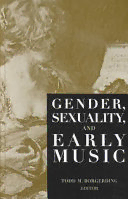
Gender, Sexuality, and Early Music PDF
Preview Gender, Sexuality, and Early Music
GENDER, SEXUALITY, AND EARLY MUSIC CRITICISMAND ANALYSIS OF EARLY MUSIC JESSlEANN OWENS,Series Editor Professor ofMusic Brandeis University TONALSTUCTURESINEARLYMUSIC editedbyCristleCollinsJudd COUNTERPOINTAND COMPOSITIONAL PROCESSINTHETIMEOF DUFAY Perspectivesfrom GermanMusicology editedbyKevinN.Mall THELANGUAGEOFTHEMODES Studies intheHistoryof PolyphonicModality byFransWiering GENDER, SEXUALITY,AND EARLYMUSIC editedbyToddM.Borgerding GENDER, SEXUALITY, AND EARLY MUSIC EDITED BYTODD M.BORGERDING ROUTLEDGE N EW YORK AND L ONDON Publishedin2002by Routledge 29West35th Street NewYork,NY 10001 PublishedinGreatBritainby Routledge II NewFetterLane London EC4P4EE Routledgeisanimprint oftheTaylor& Francis Group Copyright©2002byToddM.Borgerding PrintedintheUnitedStatesofAmericaonacid-freepaper All rights reserved. No part of this publication may be reproduced, stored in a retrieval system, ortransmitted,inanyformorbyanymeans (electronic,mechanical, photocopy, recording,orotherwise)withoutpriorpermissionofthepublisher. 10 9 8 7 6 5 4 3 2 LibraryofCongressCataloging-in-PublicationData Gender, sexuality,andearlymusicIeditedbyToddM.Borgerding. p.cm- (Criticismandanalysisofearlymusic) includesbibliographicalreferences(p.)andindex. ISBN0-8153-3394-3(alk.paper) I.Genderidentity inmusic.2.Sexinmusic.3.Music-Europe-16thcentury Historyand criticism.4.Music-Europe-17thcentury-Historyandcriticism. 1.Borgerding,ToddM.n.Criticismandanalysisofearlymusic ML3838.G3732001 780'.82'09031- dc21 2001016217 Contents SeriesEditor'sForeword Vll Acknowledgments IX Introduction XI TODD M.BORGERDlNG I. Isabella Medici-Orsini:APortraitofSelf-Affirmation DONNAG.CARDAMONE 2. "Similcombattimentofatto daDame":The Musico- 27 theatricalEntertainmentsofMargheritaGonzaga's balletto delledonne and the FemaleWarriorinFerrarese Cultural History NINATREADWELL 3. MadalenaCasulana:mybodyknows unheardofsongs 41 THOMASIN LAMAY 4. Chaste Warriors andVirginMartyrsin 73 FlorentineMusical Spectacle KELLEY HARNESS 5. Le nonnedella ninfa: Feminine VoicesandModal 123 Rhetoricinthe Generations before Monteverdi LAURIESTRAS 6. Gossip,Erotica,and the Male SpyinAlessandro 167 Striggio'sJlCicalamento delledonnealbucato (1567) CHRISTINAFUHRMANN v vi Contents 7. Construction ofDesireinEarlyBaroque 199 Instrumental Music ANDREWDELLANTONIO 8. Music, Sex,andEthnicity: Significationin 227 Lully'sTheatrical Chaconnes ROSEA. PRUIKSMA 9. Sicegotedilegebam:Music,Homoeroticism,andthe 249 SacredinEarlyModern Europe TODD M.BORGERDlNG 10. ChristinedePizanand 'Dueil Angoisseux' 265 LIANECURTIS Postscript: DancingwiththeIngrate 283 SUZANNECUSICK Contributors 289 Index 293 Series Editor's Foreword General Introduction to Criticism and Analysis ofEarly Music JESSIEANN OWENS Recentyearshaveseenacriticalreassessment ofourapproachtoearlymusic. Musicians,scholars,andcriticshavebeensearchingforwaysoftalkingabout and reacting to the music that engage it not from the perspective of later music butratheronitsownterms.Thesenewapproaches wouldnotbepossi blewithout the scholarship ofthe previousdecades.The discovery and cata loguing of musical sources, the preparation of crtitical editions, and the investigation of archival documents have furnished important information aboutcomposers,performers,patrons,andinstitutions thatsupportedthecre ation and performance ofearly music. Building on this work,the editors of these volumesnowseektodevelop andexplore analytical methodologiesfor thediscussion ofearlymusic asmusic. Analytic methods are not easily found for early music.The theorists of thetime hadtheir ownagendas,andtheydonot providemodels that suitour purposes.As a consequence, many twentieth-century scholars have chosen approaches thatreflect their ownbeliefs aboutearly musicand itsrelation to later music.While some continue to rely on common practice tonality as a prismthrough whichtoviewearlymusic,othershavebeguntoexploremeth ods that respect the integrity and self-sufficiency of the languages ofearly music. We offer a forum for exploration of particular topics, from both a methodological andcritical viewpoint. Ourpremiseisthatwecanbestdevel ope new methodologies by encouraging debate. We will explore composi tional procedures, tonal structures, musical borrowing, and other topics, focusing both on individual compositions and on theoretical systems. We seektoencourage critical writing about musicthatwillbeusefultoperform ers,listeners,andscholars. vii Acknowledgments The task ofmarshalling agroup ofauthorsdispersed from California to the British Isles is a formidableone;but the contributors to this volume, whose cheerful andrapid responses tomye-mails,faxes,andtelephone callsduring the period that this volume was under construction,made lighterwork ofit, andhavemygratitude.SotoodothestaffatRoutledge publishers:thanks are due to Soo Mee Kwon, the former music editor and her assistant Gillian Rodger,whopatientlyguided thevolume through much ofitsformation,and tothepresenteditorRichard CarlinandhisassistantRachael Shookwhosaw the project through to publication. Finally,my grateful appreciation to Leo Balkto whomthe present volume owesitsinception, andto the serieseditor JessieAnnOwens,towhoseencouragementitowesitscompletion. ix Introduction TODD M. BORGERDING "Music isindeed wellsuited to women, andperhaps alsotoothers whohave theappearanceofmen, butnotto realmen;forthelatter oughtnottorender theirminds effeminate andafraidofdeath."'Thewell-knowndeclarationofa Renaissance courtier reminds us, perhaps better than any other document, that attitudes connectinggender andsexuality tomusic inherited fromantiq uity occupied acentral position in the epistemology ofearly modem music. And while the men populating Castiglione's court ultimately reassure the reader (andthemselves) that,bytheauthority ofPlato,Aristotle, Lycurguset aI., music need not necessarily negate masculinity, yet the anxious note of their discourse showsthattheydidnotforgetthose women,orthose emascu latedmen,whosepresencetheysoacutelysensed.Thisisworthremembering ifonlybecause wehavefor solongaccepted male heterosexualityasnorma tive; but the rhetoric of the courtiers exchange, proceeding from a norm (women, effeminate men) in order to define the exception ("real men" who playmusic)suggeststhatthesituation inearlymodemEuropewassomewhat morecomplicatedthanthat. Recentmusical scholarship onearlymodemrepertorieshas,infact,been busy complicatingthediscourse ofmusicology. Scholars drawing onthetra ditions offeminism, genderstudies, and queer studies (who havesometimes been described aspracticingthe"New Musicology")havealongtradition of being received with a polemic that reproduces the anxiety ofCastiglione's courtiers.However,itmight beclaimed that the unease with which the topic ofgender andsexuality hasbeen sometimes met inthe modemacademy has lessened since the years when essays by such scholars as Susan McClary or Suzanne Cusick wouldraiseamaelstromofopposition, withthe masculinity ofnot onlymusic, but the discipline ofmusicology at stake. Now,ifcontro versy exists, its tone is somewhat less strident, and the study of gender and sexuality hasbecome apart ofourmainstream musical culture.These topics xi
